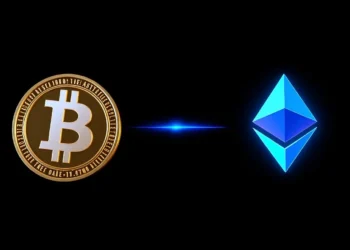Imagine the internet. Lots of websites exist on it, right? Blockchain is like the internet. Bitcoin is just one website on that internet, a single application. Understanding the difference can be confusing. Many people mix them up. The core difference is this: Bitcoin is a cryptocurrency; blockchain is the technology that makes it work.
What is Blockchain Technology?
Blockchain is a new kind of database. It’s changing how we think about information.
Defining the Digital Ledger
Think of blockchain as a digital record book. It keeps track of transactions. This record is spread across many computers. This makes it hard to change or hack. Each transaction is put in a “block.” These blocks are linked together in a “chain.” Special codes called “cryptographic hashes” keep everything secure. It’s a distributed, immutable, and transparent ledger.
Key Characteristics of Blockchain
Blockchain has some cool features. It’s immutable, which means records can’t be changed once added. It’s also decentralized, so no single person controls it. Everything is transparent, meaning everyone can see the transactions. To make sure everyone agrees, blockchains use something called “consensus mechanisms.” Two popular ones are Proof-of-Work and Proof-of-Stake. They help keep the network secure and honest.
Real-World Applications of Blockchain (Beyond Cryptocurrency)
Blockchain isn’t just for cryptocurrencies like bitcoin. It can be used in many ways. Think about tracking products as they move from place to place. That’s supply chain management. It can also keep medical records safe in healthcare. Blockchain could even make voting more secure. You can even use it for managing digital identity. Walmart uses blockchain to track where its food comes from. It helps them find and remove bad food faster.
What is Bitcoin?
Bitcoin is a digital type of money. It’s not controlled by any bank or government.
Bitcoin as a Cryptocurrency
Bitcoin is a peer-to-peer electronic cash system. That means people can send money directly to each other. No bank is needed. It was created by someone named Satoshi Nakamoto. They wrote a paper explaining how it works. This paper is called the Bitcoin whitepaper.
How Bitcoin Transactions Work
Sending Bitcoin is pretty simple. You need a Bitcoin “wallet”. It’s like a digital bank account. You use the wallet to send Bitcoin to someone else’s wallet. “Miners” help make sure the transaction is valid. They check the transaction and add it to the Bitcoin blockchain. Miners get rewarded with new Bitcoin for their work.
Bitcoin’s Strengths and Limitations
Bitcoin has strengths and weaknesses. It’s decentralized, which makes it hard to control. It’s secure. But it also has problems. Bitcoin can be slow when many people use it. The price of Bitcoin can change a lot too.
Blockchain vs. Bitcoin: Key Differences Explained
Let’s break down the main differences. They aren’t the same thing.
Purpose and Functionality
Blockchain is a toolbox. Bitcoin is one thing you can build with it. Blockchain enables many applications, not just Bitcoin. Bitcoin relies on blockchain. But blockchain doesn’t need Bitcoin to exist.
Scope and Applicability
Blockchain can be used in many industries. It is adaptable. Bitcoin is mostly used for money stuff. Blockchain has broad applicability.
| Feature | Blockchain | Bitcoin |
|---|---|---|
| Primary Purpose | Technology Platform | Digital Currency |
| Scope | Wide range of Applications | Primarily Financial Transactions |
| Dependence | Independent | Relies on blockchain |
| Control | Can be permissioned or permissionless | Permissionless (open to all) |
Technical Architecture
Blockchains and Bitcoin use different tech. They might use different computer languages. They also have different ways of agreeing on things (consensus algorithms). The way they are set up on networks also differ.
Benefits and Drawbacks of Blockchain and Bitcoin
Let’s weigh the good and the bad. Each has its own challenges and perks.
Advantages of Blockchain
Blockchain offers better security. It’s more transparent. It can make things faster and cheaper. This can lead to improved security, more openness, better efficiency, and cost savings.
Disadvantages of Blockchain
Blockchain can have trouble handling lots of transactions. Rules about it aren’t always clear. It can also be complex. Scalability is an issue, and there’s regulatory uncertainty.
Advantages of Bitcoin
Bitcoin is decentralized. No one can stop you from using it. Anyone in the world can use it.
Disadvantages of Bitcoin
Bitcoin’s value can go up and down a lot. Governments might not like it. It also uses a lot of energy. This is due to Proof-of-Work. Bitcoin is volatile and there are regulatory concerns.
The Future of Blockchain and Bitcoin
What’s next for these technologies? The future looks bright.
Potential Evolution of Blockchain Technology
Blockchain might get faster. Different blockchains might start working together. Big companies might start using it more. Focus will be on scalability, interoperability, and enterprise adoption.
Future of Bitcoin
Bitcoin might become like digital gold. More people might accept it. Governments might create rules for it. It has the potential for mass adoption.
Conclusion
Blockchain and Bitcoin are different things. Blockchain is the underlying tech. Bitcoin is a cryptocurrency that uses it. Both have a lot of potential to change the future. Learn more and stay informed!

























